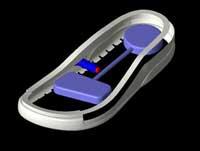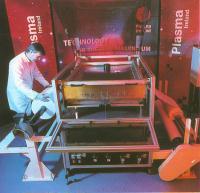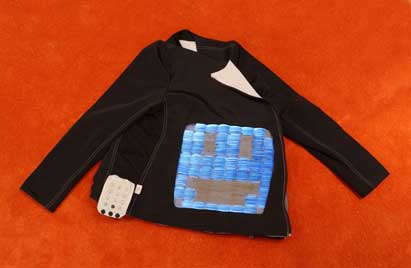New textiles for new garments
2003/06/18 Kortabarria Olabarria, Beñardo - Elhuyar Zientzia

The day to day textile industry is based on a surprise. Every day it creates new surprises: clothing that resists stress, fabrics that help to sleep better, able to absorb solar radiation or kill bacteria, shoes that carry the phone, pants that do not wrinkle… The research that is being carried out in this field moves hundreds of millions of euros a year and, according to experts, the new fashion will be one of the bases of the economy.
It is clear that the textile revolution is underway. And it seems that it is also unstoppable. Experts and researchers agree that the clothes of the future will be equivalent to the second skin of the human body. The garments will be made with very fine materials, but at the same time the garments will be very resistant and flexible. In addition, they will have the opportunity to go dresses of elegant elegance and other options. The goal is to feel good. Designers are looking for useful, light and non-moving suits. And very important: that they are easy to clean and iron, or that there is no need to clean or iron. Therefore, behavior adjusted to the needs of consumers.
Microfibers
XX. Until the mid-twentieth century, man used natural fabrics to dress. Cotton, wool, linen, silk, etc. were used to make the garments. In 1935 the scientist Wallace Carothers created a material called fiber 66, which is then known as nylon. This fiber replaced the silk used to make socks, since the socks were very expensive. Two years later, in Germany, elastane was invented. And when these two fibres joined together, in the 1970s, the famous Lycra was launched and the synthetic fibres revolution arrived.
Since elastane replaced natural fibers, the textile industry has experienced spectacular advances. Microfiber research is driving new development. Microfibers are much thinner synthetic materials than silk and, together with synthetic fibers from plastic, brighter and softer. They are also flexible and comfortable. However, the ultraviolet ones that are currently developing are much thinner. Microfibers are 60 times thinner than human hairs, while ultraviolets 180 times. Names like Tactel, supplex, softec will soon become vulgar, as in their time they became polyester, latex, the lycra itself or the gore-texa.

As in other areas of this society, the first signs of progress are manifested in sport. The athlete, in addition to being a perfect showcase, becomes an ideal sports practice for testing. Seamless bathing suits, or teflon and lycra suits that dry immediately after water, garments that adapt to temperature, sweaters, garments specially designed to avoid fatigue, etc. have already begun to be used. In the last Olympic Games, Australian swimmer Ian Thorpe used a swimsuit that reduced the coefficient of friction. Therefore, the swimsuit was more slippery than the body itself; an obvious advantage.
New products
The changes that have occurred not only in sport, but also in clothing used in other areas are notorious. Many of them are based on technologies to combat cold and heat. For example, the Italian Corpo Nove has launched a light and warm jacket on the market. Baptized as absolute zero, he proves it in Antarctica. The jacket resists body heat despite the outside temperature of -50 degrees Celsius. For this purpose it uses superinsulating material, silicon based aerogel 3 millimeters thick.
You also have to go to the other extreme, to the garments to combat the heat. The engineers of Karada Italia have prepared, together with the designers of the fashion house Hugo Boss, underwear with refrigeration. This allows McL team mechanics to work more safely at high temperatures. The clothes have a 50 metre tube with coolant. The Spanish company Zodiac has designed a similar system, but the goal is to protect the police from whales from criminals.
Footwear also has a place in the latest textile technology. The European Space Agency and a group of European companies are working on the development of a soil capable of modifying compactness according to the characteristics of the terrain. This would reduce the pressure that the foot must bear. It is being researched with a fluidizing material called MR, which was actually invented to cushion vibrations. Under the influence of magnetic fields the MR can pass from solid state to liquid and vice versa.

They are only the first steps, but it seems that the trend of fashion is clear: advance with the advancement of the latest technology. It seems, therefore, that the image of a futuristic silver fashion in an era will be left behind.
Wardrobe of the new millennium
Some of the garments listed below may be closer to reality than to science fiction and may not appear anywhere else except at textile fairs. However, they are investigating and may someday not be so strange. Some of the lists, such as heated clothing, are already on sale.
- T-shirts capable of detecting any type of pain and transmitting information about vital constants.
- Camouflage clothing capable of isolating the smell of the wearer. In addition, it will adapt its appearance to the environment.
- Heated clothing: optical and fine fibers that will make garments with high insulation capacity obtained.
- Clothing adjusted to the mood of the person. The color of clothing will change through sweat or body temperature.
- Socks that accelerate blood circulation.
- Black underwear.
- Clothes to listen to music.
- Clothes with memory. That is, clothes can detect things that are normally carried in the pockets. If anyone forgets, he will warn.
- Clothing with microcamera to control children who must be permanently monitored. There is already a pyjama of these characteristics called Mamagoose on the market.
Clothes you feel
Fibers that respond to stimuli they receive from the outside. There is the definition of smart fibers. Looking ahead, experts say that this type of clothing will be able to resist stress, ward off insects, help sleep better, absorb ultraviolet radiation...

They look like future issues, but smart fiber technology is already becoming a reality. Perhaps the most advanced line of research on this path is that of antimicrobes that prevent the proliferation of bacteria. Nuria Oliver works at the American research agency MIT, where she says: "The main idea is to place small sensors and computers on garments.
These tools can meet people, be able to know that the user's blood pressure has increased, or simply remember the need to buy milk." According to the Spanish researcher, clothing and the human body are in contact, so clothing can become an ideal means to extract information about the body. "For example, you can control the rhythm of the heart or tell the diabetic that the glucose level has increased a lot."
Thus, in addition to clothing designers, chemists, physicists, engineers, telecommunications technicians, integrated circuit designers or telematics experts are working in the fashion world. The first results of this collaboration have already appeared on the market. Levi’s, for example, has launched the first jacket with music and phone audition. Price exceeding 1.000 euros. The jacket has not been very successful on the market, as in addition to being expensive, it is a weight. However, it has served to better understand the drawbacks that garments made with this type of technology can have in the market.
One of them may be the time to clean the jacket, although in the future the jacket itself is expected to request cleaning when you need it. The jackets on the market have 1.2 meters of cable. Because they work with little energy, it would be almost impossible to receive the electric shock when they get wet, but people don't trust.
Another challenge of the industry is the integration between circuits and fiber. Cables, microchips, and other components will be placed between the fiber to prevent them from coming into contact with the skin and causing surface problems. To achieve this type of precision, experts have had to resort to nanotechnology, a field that is still in its beginnings.

Power supply is also not a problem. The batteries will be small, but at some point they must be charged and available for it. Of course, this limits both fashion designers and potential users. Although at the moment all components work with batteries, MIT researchers study the ways to harness the energy generated by the human body when moving.
Although there are examples that help to imagine how the future of fashion can be, it is still not possible to date such clothes. That is, when will they be normal? Those in the fashion world speak of the year 2015, but it remains to be seen whether that smart tech clothing will be available to everyone.
Published in D2 section of Deia.

Gai honi buruzko eduki gehiago
Elhuyarrek garatutako teknologia






